Madhulika Singh
Madhulika Singh is an agricultural scientist working with CIMMYT in India.
For more information, contact CIMMYT’s India office.
Madhulika Singh is an agricultural scientist working with CIMMYT in India.
In the traditional Indian society Madhulika Singh grew up in, girls choosing to study science, technology, engineering or mathematics (STEM) was as radical as choosing a life partner on their own.
“They say women hold up half the sky. I believe they should hold up as much and contribute equally in STEM too,” says Singh, now an agriculture specialist at the International Maize and Wheat Improvement Center (CIMMYT).
In her early teens she saw her mother, a school headmaster, comfortably navigate her career along with her domestic responsibilities without a sweat. She later saw a similar example in her sister-in-law. “I grew up thinking ‘there is so much that a woman is capable of,’ whether at home or her workplace,” Singh recalls.
This strong idea of women’s potential led her to pursue studies in science. “Many women before me, like my mother’s generation, were encouraged to take up [careers in] humanities — become a teacher, or pursue home management courses — to ensure a smooth transition once married,” Singh explains. She hoped this would change during her time and that following a career in STEM would be a matter of choice — not gender.
Singh’s goals and ambitions were very clear from the very beginning. In school, she was interested in biology, particularly plant studies and botany. Her inquisitive nature was reflected in her projects and presentations, scoring her high grades. She demonstrated a thorough understanding of plant physiology and her passion for the subject. The budding scientist always wanted to know more and to do more, which Singh feels resonates with her current research and publications.
A popular quote attributed to Mahatma Gandhi says “Be the change you want to see in the world.” When Singh chose to take up plant science in graduate school and then agriculture science for her doctorate, she became the change she had hoped to see in her home and society as a young girl. With the support from her family but a skeptical society, she went ahead and pursued a career in STEM, beginning her research on maize genotypes and conservation agriculture. In 2013 she joined CIMMYT as a physiologist.
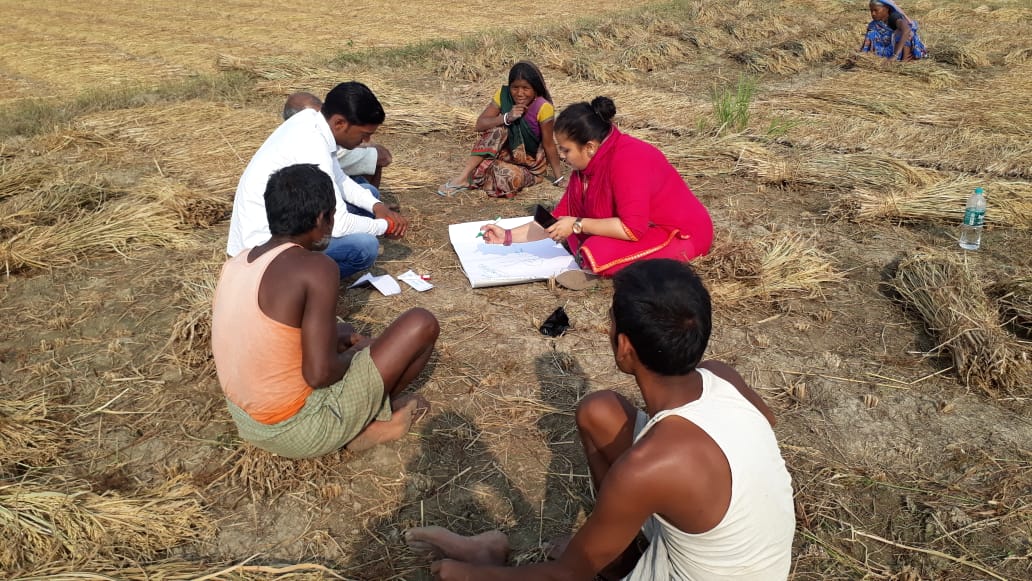
Helping farmers transition to conservation agriculture
Singh currently works in her home state of Bihar for the Cereal Systems Initiative for South Asia (CSISA), led by CIMMYT. She is engaged with over ten thousand farmers from the states of Bihar and Uttar Pradesh, supporting the adoption of conservation agriculture practices.
Farming is vital for the region, as nearly 70% of the population is engaged in agriculture and extension services. However, food and livelihoods are threatened by the small size of farms, low incomes, and comparatively low levels of agricultural mechanization, irrigation and productivity.
Singh and her colleagues have led the transition from traditional farming to sustainable intensification practices — like early wheat sowing, zero tillage and direct-seeded rice — which have helped smallholder farmers increase their yield potential substantially.
“We believe a project like CSISA, along with the government and partners, can help advance and support in realizing the full agriculture potential of these regions,” Singh explains.
Roots in the soil
Her grandparents were farmers. “To be able to care for the land that provided you nourishment and a living was always admired upon,” she says. As a crop scientist, Singh’s family acknowledges her work as an extension of the services her grandparents practiced.
Sustained by this motivation and encouragement, Singh feels reassured of her role: joining other scientists, partners and farmers to make agriculture sustainable and our communities food-secure.
“The fact that the data we generate from our experiments serve as building blocks in the generation of knowledge and help farmers optimize the cost of inputs and increase their productivity is fulfilling and enriching to me,” Singh expresses.
Apart from working to build the capacity of farmers and extension workers, Singh supports the implementation of field trials and community-based technology demonstrations. She also helps refine key agricultural innovations, through participatory testing, and optimizes cropping systems in the region.
Leading the way for for the next generation
A true representative of the STEM community, Singh is always learning and using her experience to give back to society. She has co-authored numerous books and contributed to journals, sharing her knowledge with others.
Other women leaders in STEM have inspired Singh in her professional life, including CIMMYT’s former deputy director general for research Marianne Banziger. Singh believes Banziger was trailblazing and that young girls today have many female role models in STEM that can serve as inspiration.
The change is already here and many more young women work in STEM, pursuing excellence in agriculture sciences, engineering and research studies contributing to as well as claiming “half the sky.”
Cover photo: CIMMYT researcher Madhulika Singh (center-right) stands with farmers from self-help groups in the village of Nawtanwa, West Champaran, in India’s Bihar state. CIMMYT works on gender inclusion and participation through partnerships with other organizations and self-help groups. (Photo: CIMMYT)

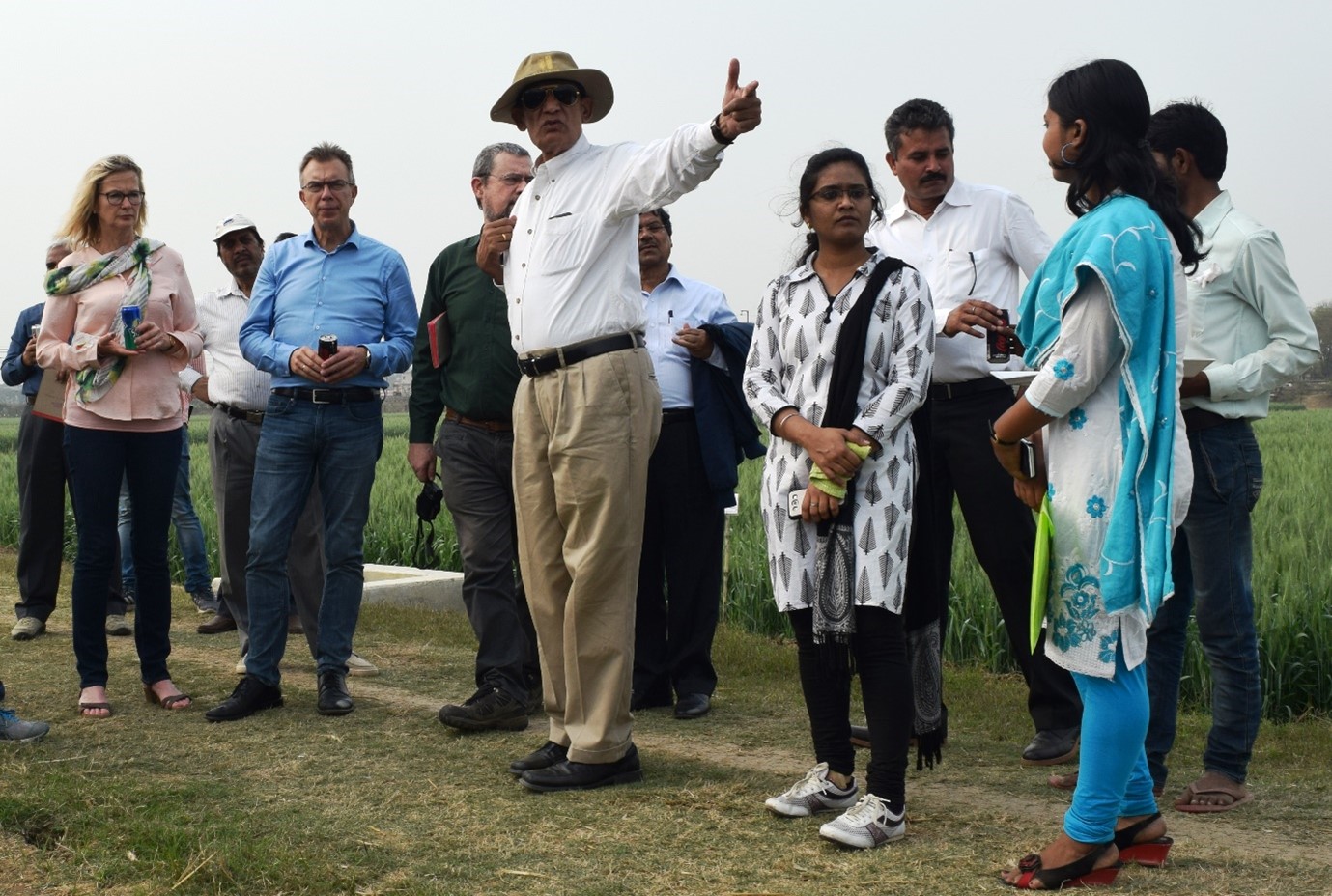
Today the Weed Science Society of America (WSSA) announced the Honorary Member award for Ram Kanwar Malik, senior scientist at the International Maize and Wheat Improvement Center (CIMMYT). This award is given every year to a person who has made outstanding contributions to weed science “through their research, teaching, publishing and outreach.”
Malik’s early engagement in agricultural sustainability led to initiatives exploring herbicide resistance evolution and management, zero tillage, and other resource-conservation technologies. At the Cereal Systems Initiative for South Asia (CSISA) — a regional project led by CIMMYT — Malik and his colleagues helped promote the practice of early wheat sowing to beat terminal heat stress, resulting in increased wheat yield in India’s eastern Indo-Gangetic Plains.
“WSSA’s Honorary Member award is one of the highest recognitions bestowed by the Weed Science Society of America,” said Krishna Reddy, Chair of the WSSA 2022 Award Committee. “[The] Honorary Member is selected for meritorious service to weed science, among non-members from North America or any weed scientist from other countries. Only one person per year is awarded this membership. Dr. Malik’s significant research in weed science and his collaborative effort to deliver solutions for farmers in developing countries like India is inspirational.”
The award was presented virtually at the 2022 annual meeting of WSSA, held in Vancouver, Canada.
Transforming rice–wheat systems
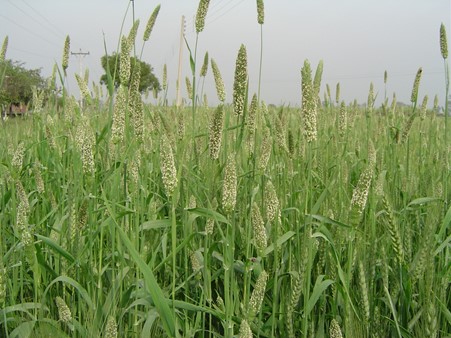
Malik has worked extensively in the Indo-Gangetic Plains, leading many initiatives and innovations over the years, in collaboration with national and international partners. The WSSA award highlights Malik’s inspiring work in tackling herbicide resistance problems, first reported in India by his team in 1993. Malik was instrumental in developing a management solution for herbicide-resistant Phalaris minor, a pernicious weed in wheat crops. The integrated weed management system he helped develop raised wheat yield capacity significantly for farmers in the Indo-Gangetic Plains.
“The WSSA Honorary Member award reiterates the importance of agronomic management for sustained weed control strategies across cropping systems,” Malik said. “CIMMYT and partners, including the Australian Centre for International Agricultural Research (ACIAR), were the first to introduce zero tillage in wheat as part of a strategy to manage weed resistance problems in India. It is an honor that WSSA has recognized this collective work of ours,” he acknowledged.
Malik has devoted more than thirty years to transforming agricultural systems in the Indo-Gangetic Plains, working closely with farmers and partners, and building the capacity of national agricultural and research extension systems. he is a firm believer in farmers’ participation: “Large-scale adoption of sustainable agricultural practices is possible when we work together to leverage technologies which are mutually agreed by partners and meet farmers’ needs.”
Malik is a fellow of the Indian Society of Agronomy and the Indian Society of Weed Science (ISWS), which granted him the Lifetime Achievement Award. He has also received the Outstanding Achievement Award from the International Weed Science Society (IWSS) and the 2015 Derek Tribe Award from the Crawford Fund.
He remains passionate about and invested in changing the lives of farmers through better-bet agronomy and by leading innovative research at CIMMYT.
About the Weed Science Society of America (WSSA)
Founded in 1956, WSSA is a nonprofit scientific society that encourages and promotes the development of knowledge concerning weeds and their impact on the environment.
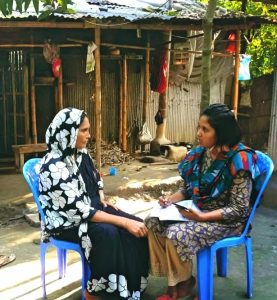
Researchers at the International Maize and Wheat Improvement Center (CIMMYT) have studied and witnessed that women, particularly in South Asia, have strongly ingrained and culturally determined gender roles.
While women play a critical part in agriculture, their contributions are oftentimes neglected and underappreciated. Is there any way to stop this?
On International Day of Women and Girls in Science, we spoke to Pragya Timsina about how women’s participation in agriculture is evolving across the Eastern Gangetic Plains and her findings which will be included in a paper coming out later this year: ‘Necessity as a driver of bending agricultural gender norms in South Asia’. Pragya is a Social Researcher at CIMMYT, based in New Delhi, India. She has worked extensively across different regions in India and is currently involved in various projects in India, Nepal and Bangladesh.
What is the current scenario in the Eastern Gangetic Plains of South Asia on gender disparities and women’s involvement in agriculture? Is it the same in all locations that your research covered?
Currently, traditional roles, limited mobility, societal criticism for violating gender norms, laborious unmechanized agricultural labor, and unacknowledged gender roles are among the social and cultural constraints that women face in the Eastern Gangetic Plains. Our research shows that while these norms exist throughout the Eastern Gangetic Plains, there are outliers, and an emerging narrative that is likely to lead to further bending (but not breaking, yet) of such norms.
Are there any factors that limit women from participating in agriculture?
Cultural and religious norms have influence gender roles differently in different households but there are definitely some common societal trends. Traditionally, women are encouraged to take on roles such as household chores, childcare, and livestock rearing, but our research in the Eastern Gangetic Plains found that in specific regions such as Cooch Behar (West Bengal), women were more actively involved in agriculture and even participated in women-led village level farmers’ groups.
How or what can help increase women’s exposure to agricultural activities?
At the community level, causes of change in gender norms include the lack of available labor due to outmigration, the necessity to participate in agriculture due to a labor shortage, and a greater understanding and exposure to others who are not constrained by gendered norms. There are instances where women farmers are provided access and exposure to contemporary and enhanced technology advances, information, and entrepreneurial skills that may help them become knowledgeable and acknowledged agricultural decision makers. In this way, research projects can play an important role in bending these strongly ingrained gendered norms and foster change.
In a context where several programs are being introduced to empower women in agriculture, why do you think they haven’t helped reduce gender inequality?
Our study reveals that gender norms that already exist require more than project assistance to transform.
While some women in the Eastern Gangetic Plains have expanded their engagement in public places as they move away from unpaid or unrecognized labor, this has not always mirrored shifts in their private spaces in terms of decision-making authority, which is still primarily controlled by men.
Although, various trends are likely to exacerbate this process of change, such as a continued shortage of available labor and changing household circumstances due to male outmigration, supportive family environments, and peer support.
What lessons can policymakers and other stakeholders take away to help initiate gender equality in agriculture?
Although gender norms are changing, I believe they have yet to infiltrate at a communal and social level. This demonstrates that the bending of culturally established and interwoven systemic gender norms across the Eastern Gangetic Plains are still in the early stages of development. To foster more equitable agricultural growth, policymakers should focus on providing inclusive exposure opportunities for all community members, regardless of their standing in the household or society.
What future do the women in agriculture perceive?
Increasing development projects are currently being targeted towards women. In certain circumstances, project interventions have initiated a shift in community attitudes toward women’s participation. There has been an upsurge in women’s expectations, including a desire to be viewed as equal to men and to participate actively in agriculture. These patterns of women defying gender norms appear to be on the rise.
What is your take on women’s participation in agriculture, to enhance the desire to be involved in agriculture?
Higher outmigration, agricultural labor shortages, and increased shared responsibilities, in my opinion, are likely to expand rural South Asian women’s participation in agricultural operations but these are yet to be explored in the Eastern Gangetic Plains. However, appropriate policies and initiatives must be implemented to ensure continued and active participation of women in agriculture. When executing any development projects, especially in the Eastern Gangetic Plains, policies and interventions must be inclusive, participatory, and take into account systemic societal norms that tend to heavily impact women’s position in the society.
On this International Day of Women and Girls in Science, CIMMYT speaks to Tripti Agarwal, whose research paper delves into the impact of Climate-Smart Agricultural Practices (CSAPs) on women and farming households in Bihar, India. CSAPs offer a promising solution to address environmental issues through gender-inclusive technological interventions. As we celebrate the achievements of women in science today, we see CSAPs bridging the gender gap and empowering women.
Hello Tripti, it’s great to talk to you about labor migration and how the adoption of CSAPs ensures household food security. Could you share how this approach influences gender equality in farming households?
My paper is titled “Gendered impacts of climate-smart agriculture on household food security and labor migration: insights from Bihar, India.” Bihar is highly vulnerable to hydro-meteorological natural disasters that cause agricultural production loss. The issue is that the male workforce migrates to other cities to seek different employment opportunities and improve their families’ livelihoods, often leaving the women behind to farm. Women left behind are then responsible for household and farming activities, making them overburdened. Therefore, Climate Smart Agricultural Practices (CSAPs) could play a vital role in safeguarding the loss in production and supporting livelihoods. The concept of Climate-Smart Villages (CSVs) links this, acknowledging the gender gap and striving to promote gender-equitable approaches in knowledge enhancement, capacity development, and better practices. CSAPs empower women to support farming decision-making and a better utilization of resources
That is interesting. Would you also tell us how the CSV program addresses climatic risks from technological and social perspectives?
As per the study I mentioned earlier, climatic stress that affects crop production directly impacts a household’s food security and, more severely, women’s food security. The CSV program promotes adopting climate-resilient practices and technologies that mitigate the risk of crop loss and ensure enough food for the household. CSV is a promising solution to address environmental issues through gender-inclusive technological interventions.
Ensuring food for the household is the most important thing. We also see that this paper highlighted the knowledge gaps between men and women farmers in terms of CSAPs. What action plan is needed to have a more equitable gender-responsive environment at the policy level?
The paper attempts to drive the concentration of the state/policymakers in providing more opportunities to women in having access to resources. Policies or strategies — driven towards ensuring female education, knowledge and capacity building — are likely to play a significant role in providing access and control of resources to women across their lifetimes in varied areas of work.
As per the research paper, the probability of out-migration is reduced by 21% with the adoption of CSAPs. What factors do you think are the critical indicators of this trend?
The increase in knowledge about CSAPs, both for men and women, supports household decision-making in adopting CSAPs. With the adoption of CSAPs, the increase in agricultural production reduced the compulsion of males to migrate, and better female literacy also had a negative and significant effect on male out-migration
The study also reveals that the farmer’s education has a direct impact on the adoption of CSAPs. Is there any plan to bridge this gap? Or a suggestion for the policy makers to address this issue?
There are two steps to be covered on this front. First, to have gender-equitable knowledge dissemination and to ensure that women receive the required and necessary information about CSAPs. For this, the role of women in society needs to be strengthened and would primarily come from (i) support from the family & society and (ii) right to education. Second, knowledge alone is not enough to contribute to economic activities. Gender-inclusive strategies need to be framed and implemented to provide women the required access and control over resources. For this, multi-sectoral efforts are necessary, like having policies from the government, corporates supporting the cost of efforts, specialized agencies providing the expertise, NGO partners working with the community, and foremost, support from the society.
Very rightly said, and we hope that some strong measures are taken at the policy level. Today, women play a huge role in agriculture; thus, it becomes vital to enhance their capacities, especially in newer technologies. In this context, what approaches can you suggest to strengthening their skills and knowledge to achieve a gender-empowered agricultural domain?
There is no limit to enhancing the skills and capacities of an individual. And when we talk about women, especially in rural/agricultural contexts, we see that support from the family is critical for them. To ensure that, we need ways to educate men on how women can support them in providing better livelihoods. Creating plans and roadmaps for women would help achieve a gender-empowered agricultural domain, but we must also bring behavior change among men towards a more accepting role of women in farming and decision making.
One last question related to this special day. Why do you love your work? And how is science exciting for you?
I was assigned the position of Project Administrator; however, after working for many years with a team of experts, my interest in research slowly ignited. Thanks to the support I received, I decided to work closely on the subject and identify the areas where I may add value. Linking my knowledge and field studies, I started contributing to relevant publications like this one, which is the output of my years of experience at CIMMYT. I received a lot of support from my team, especially from Dr. M.L. Jat, who has been a great mentor throughout my journey of learning and growth.
M.L. Jat is a Principal Scientist at CIMMYT and co-author of the article. Building on this publication, CIMMYT’s gender research will be further strengthened under the One CGIAR Regional Integrated Initiative on Transforming Agri-Food Systems in South Asia (TAFSSA), which has a core learning site in Bihar.
India has conferred posthumously upon Sanjaya Rajaram, 2014 World Food Prize laureate and former wheat breeder and Director of the Wheat Program at the International Maize and Wheat Improvement Center (CIMMYT), its prestigious 2022 Padma Bhushan Award in “Science and Engineering” in recognition of “distinguished service of high order.”
Among the most successful crop breeders in history, Rajaram, who passed away in 2021, personally oversaw the development of nearly 500 high-yielding and disease-resistant wheat varieties that were grown on at least 58 million hectares in over 50 countries, increasing global wheat production by more than 200 million tons and especially benefiting hundreds of millions of the resource-poor whose diets and livelihoods depend on this critical crop. In India and the neighboring South Asian nations of Bangladesh, Nepal, and Pakistan, inhabitants consume more than 120 million tons of wheat and wheat-based foods each year.
“Dr. Rajaram was a true titan of wheat breeding and an inspiration for young researchers, training and mentoring more than 700 scientists from developing countries worldwide,” said Bram Govaerts, CIMMYT director general. “He was also a complete gentleman, comporting himself with modesty and grace despite his many honors and accomplishments; his first priority was helping and crediting others. Rajaram is an example today for all of us to keep working with the final stakeholder — the farmer — in mind.”
The rise from rural beginnings
Born on a small farm in District Varanasi, Uttar Pradesh, India, in 1943, Rajaram studied genetics and plant breeding at the Indian Agricultural Research Institute in New Delhi. After receiving his Ph.D. from the University of Sydney, he joined CIMMYT in 1969, working as a wheat breeder alongside Nobel Prize Laureate and CIMMYT scientist Norman Borlaug in Mexico. Recognizing his talent and initiative, Borlaug appointed Rajaram as head of CIMMYT’s wheat breeding program at just 29 years of age.
The Padma Bhushan Award was announced by President Ram Nath Kovind of India on the country’s Republic Day, January 26. In 2015, Rajaram received the Pravasi Bharatiya Samman award, the highest honor conferred on Indians overseas. In 2001 he accepted the Padma Shri award from the government of India and, in 1998, the Friendship Award from the government of China.
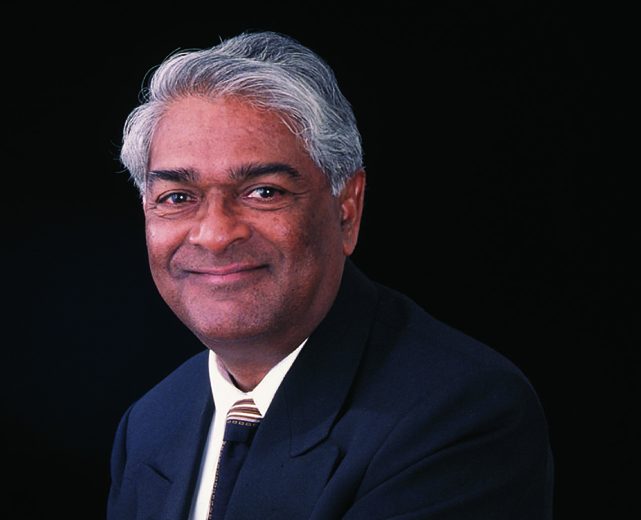
Though a plant breeder and scientist by profession, Rajaram used the platform of his 2014 World Food Prize to promote an expansive, integrated vision for agricultural development. “If we want to make a change, research won’t do it alone; we need to work directly with farmers and to train young agronomists, ensuring they have a broad vision to address the problems in farmers’ fields,” Rajaram said at a news conference in Mexico City in 2014.
Rajaram also served as Director of the Integrated Gene Management Program at the International Center for Agricultural Research in the Dry Areas (ICARDA) before formally retiring in 2008. In his retirement, he continued as a special scientific advisor to CIMMYT and ICARDA.
Longstanding partners pushing forward for farmers
“India’s agricultural research community is proud of the distinguished achievements of Dr. Rajaram,” said Trilochan Mohapatra, Director General of the Indian Council of Agricultural Research (ICAR) and Secretary of the Department of Agricultural Research and Education (DARE), of India’s Ministry of Agriculture and Farmers’ Welfare. “ICAR greatly appreciates its valuable collaborations with CIMMYT to help farmers grow better crops and conserve resources under increasingly challenging conditions.”
The partnership of India with CIMMYT harks back to the 1960s-70s, when Indian farmers tripled national wheat yields in a few years by growing Borlaug’s high-yield wheat varieties and adopting improved farming practices.
In 2011, India and CIMMYT jointly launched the Borlaug Institute for South Asia (BISA) to improve cropping systems and food security, helping farmers to confront climate change and natural resource scarcities, among other challenges.
S. Ayyappan, former ICAR Director General who signed the joint declaration of intent for BISA’s establishment in India, has been honored with the 2022 Padma Shri Award.
CIMMYT is a non-profit international agricultural research and training organization focusing on two of the world’s most important cereal grains, maize and wheat, and related cropping systems and livelihoods. Wheat varieties derived from CIMMYT and ICARDA research cover more than 100 million hectares — nearly two-thirds of the area sown to improved wheat worldwide — and bring benefits in added grain worth as much as $3.8 billion each year.
Indian agricultural researcher Pooja Bhatnagar-Mathur, a Principal Scientist at CIMMYT, says aflatoxin, a toxin produced from soil fungus and found in groundnuts like peanuts, is a serious public health and food safety problem around the globe.
Lalit Bogra is the Manager, Regional IT. He is an IT professional with 15 years of extensive experience in the non-profit sector. He manages global IT operations, and services. He utilizes technology in resource-constrained environment aligned with organizational goals. Bogra also works on Excel at strategic planning, building high-performance teams, project management, best practice methodologies and continuous improvement in services as well as fostering cultures of excellence.
Dass is a Finance & Administration Assistant working with CIMMYT’s Sustainable Intensification program at Karnal, India.
He performs finance operations such as payments, monthly closing package i.e, budget vs expenses, advance statement, bank reconciliation, petty cash statement, fixed assets and inventory records, as well as administrative and HR activities including travel logistics, procurement of capex, project assets, stationery and inventory and materials for office, laboratories, and field. He also manages employment activities as required.

On December 3, 2021, the International Maize and Wheat Improvement Center (CIMMYT) and its partners inaugurated a state-of-the-art maize doubled haploid (DH) facility in Kunigal, in India’s Karnataka state. The facility was established by CIMMYT in partnership with the University of Agricultural Sciences, Bangalore (UAS Bangalore), with financial support from the CGIAR Research Program on Maize (MAIZE).
It is the first public sector facility of its kind in Asia, fulfilling a very important need for maize breeding programs in the region. The facility, operated by CIMMYT, will provide DH production services for CIMMYT’s and UAS Bangalore’s breeding programs, as well as for national agricultural research institutions and small- and medium-sized seed companies engaged in maize breeding across tropical Asia. This is expected to result in accelerated development and deployment of a greater number of elite, climate-resilient and nutritionally-enriched maize hybrids in tropical Asia.
DH technology has the potential to enhance genetic gains and breeding efficiency, especially in combination with other modern tools and technologies, such as molecular markers and genomic selection. The facility occupies 12 acres of land at the Agricultural Research Station in Kunigal, in southwestern India. It is expected to produce at least 25,000-30,000 maize DH lines per year.
For more information, and to request these services, visit CIMMYT’s Maize Doubled Haploid Technology website.

Fast-track maize breeding in Asia
R.S. Paroda, who is a Padma Bhushan awardee in India and the chairman of the Trust for Advancement of Agricultural Sciences (TAAS) in New Delhi, thanked CIMMYT for its role in developing the facility. “The maize DH facility will revolutionize hybrid maize programs in both the public and private sectors in Asia, enabling fast-tracked development of climate-resilient and genetically diverse maize hybrids suitable for the rainfed maize-growing areas.”
S. Rajendra Prasad, vice chancellor of UAS Bangalore, appreciated the partnership between his institution and CIMMYT. “The facility will create opportunities to modernize maize breeding programs in India, besides serving as an educational and training hub for young students at the University,” he said. Members of UAS Bangalore Board of Management also participated in the formal opening of the facility.
B.M. Prasanna, director of CIMMYT’s Global Maize Program and the CGIAR Research Program on Maize (MAIZE), spearheaded the process of establishing this important breeding facility. “Along with similar maize DH facilities in Mexico and Kenya, which respectively serve Latin America and Africa, this third facility for Asia rounds up CIMMYT’s commitment to strengthen tropical maize breeding programs across the globe,” he explained.
Bram Govaerts, CIMMYT’s director general, participated through a recorded video message.
Attending the ceremony were also 150 post-graduate students, faculty from UAS Bangalore, researchers from UAS Raichur and the Indian Institute of Maize Research, CIMMYT maize scientists, and private-sector members of the International Maize Improvement Consortium for Asia (IMIC-Asia).

Collaboration networks
A technical workshop titled “Transforming India’s Agriculture and Modernizing Maize Breeding Programs” was held the same day. The workshop featured talks by Paroda on the role of youth in Indian agriculture, Prasanna on modernizing maize breeding and enhancing genetic gain, CIMMYT scientist Vijay Chaikam on maize doubled haploid technology, and CIMMYT breeder Sudha Nair on genomic technologies for maize improvement.
IMIC-Asia held a General Body Meeting soon after the technical workshop, at which B.S. Vivek, maize breeder at CIMMYT, introduced the framework for the third phase of IMIC-Asia. Participants included representatives of the Indian Institute of Maize Research, the All-India Coordinated Maize Improvement Program, and private seed companies with membership in the consortium. Meeting participants expressed a keen interest in utilizing the new doubled haploid facility’s services.
A collaboration involving 15 international institutes across eight countries has optimized efforts to introduce beneficial traits from wild wheat accessions in genebanks into existing wheat varieties.
The findings, published in Nature Food, extend many potential benefits to national breeding programs, including improved wheat varieties better equipped to thrive in changing environmental conditions. This research was led by Sukhwinder Singh of the International Maize and Wheat Improvement Center (CIMMYT) as part of the Seeds of Discovery project.
Since the advent of modern crop improvement practices, there has been a bottleneck of genetic diversity, because many national wheat breeding programs use the same varieties in their crossing program as their “elite” source. This practice decreases genetic diversity, putting more areas of wheat at risk to pathogens and environmental stressors, now being exacerbated by a changing climate. As the global population grows, shocks to the world’s wheat supply result in more widespread dire consequences.
The research team hypothesized that many wheat accessions in genebanks — groups of related plant material from a single species collected at one time from a specific location — feature useful traits for national breeding programs to employ in their efforts to diversify their breeding programs.
“Genebanks hold many diverse accessions of wheat landraces and wild species with beneficial traits, but until recently the entire scope of diversity has never been explored and thousands of accessions have been sitting on the shelves. Our research targets beneficial traits in these varieties through genome mapping and then we can deliver them to breeding programs around the world,” Singh said.
Currently adopted approaches to introduce external beneficial genes into breeding programs’ elite cultivars take a substantial amount of time and money. “Breeding wheat from a national perspective is a race against pathogens and other abiotic threats,” said Deepmala Sehgal, co-author and wheat geneticist in the Global Wheat program at CIMMYT. “Any decrease in the time to test and release a variety has a huge positive impact on breeding programs.”
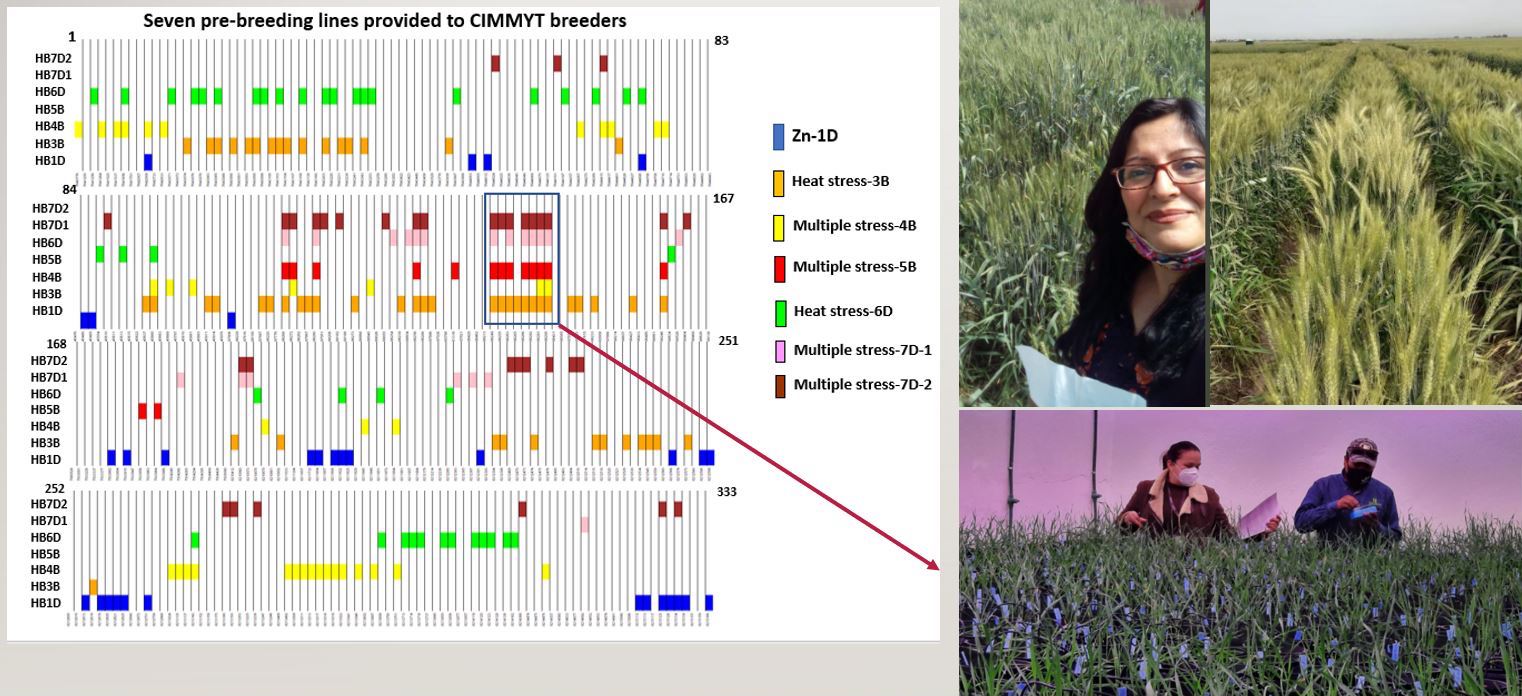
Taking into genetic biodiversity
The findings build from research undertaken through the Seeds of Discovery project, which genetically characterized nearly 80,000 samples of wheat from the seed banks of CIMMYT and the International Center for Agricultural Research in the Dry Areas (ICARDA).
First, the team undertook a large meta-survey of genetic resources from wild wheat varieties held in genebanks to create a catalog of improved traits.
“Our genetic mapping,” Singh said, “identifies beneficial traits so breeding programs don’t have to go looking through the proverbial needle in the haystack. Because of the collaborative effort of the research team, we could examine a far greater number of genomes than a single breeding program could.”
Next, the team developed a strategic three-way crossing method among 366 genebank accessions and the best historical elite varieties to reduce the time between the original introduction and deployment of an improved variety.
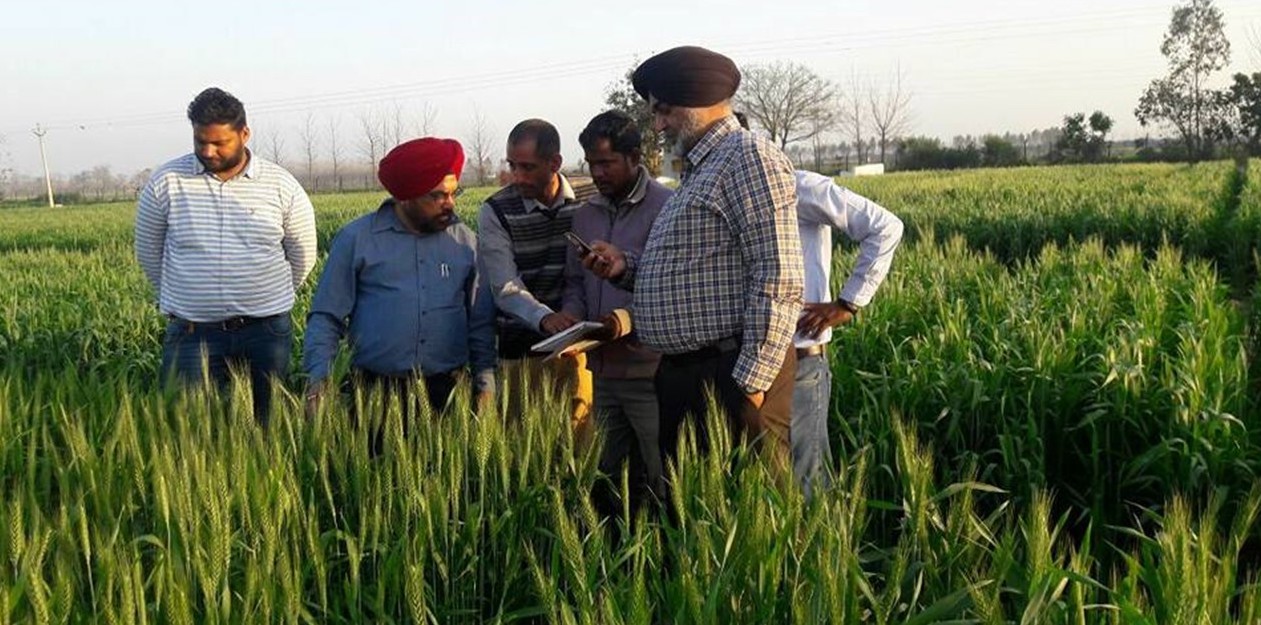
Worldwide impact
National breeding programs can use the diverse array of germplasm for making new crosses or can evaluate the germplasm in yield trials in their own environments.
The diverse new germplasm is being tested in major wheat producing areas, including India, Kenya, Mexico and Pakistan. In Mexico, many of the lines showed increased resistance to abiotic stresses; many lines tested in Pakistan exhibited increased disease resistance; and in India, many tested lines are now part of the national cultivar release system. Overall, national breeding programs have adopted 95 lines for their targeted breeding programs and seven lines are currently undergoing varietal trials.
“This is the first effort of its kind where large-scale pre-breeding efforts have not only enhanced the understanding of exotic genome footprints in bread wheat but also provided practical solutions to breeders,” Sehgal said. “This work has also delivered pre-breeding lines to trait pipelines within national breeding programs.”
Currently, many of these lines are being used in trait pipelines at CIMMYT to introduce these novel genomic regions into advanced elite lines. Researchers are collaborating with physiologists in CIMMYT’s global wheat program to dissect any underlying physiological mechanisms associated with the research team’s findings.
“Our investigation is a major leap forward in bringing genebank variation to the national breeding programs,” Singh explained. “Most significantly, this study sheds light on the importance of international collaborations to bring out successful products and new methods and knowledge to identify useful contributions of exotic in elite lines.”
Read the full article:
Direct introgression of untapped diversity into elite wheat lines
Cover photo: A researcher holds a plant of Aegilops neglecta, a wild wheat relative. Approximately every 20 years, CIMMYT regenerates wheat wild relatives in greenhouses, to have enough healthy and viable seed for distribution when necessary. (Photo: Rocío Quiroz/CIMMYT)
ML Jat, a principal scientist at CIMMYT, speaks with The Times of India about the work of CIMMYT and its partners on diversification and carbon credits—two futuristic ways to reduce greenhouse gas emissions from agriculture in India.
In India, nearly one-sixth of groundwater reserves has been overexploited and almost one-fifth of them is either in critical or semi-critical condition. For a country that relies heavily on groundwater for drinking and irrigation, these statistics are close to a death sentence.
India’s water crisis, however, is not unique in the region. Population growth, coupled with increasing urbanization and industrialization, has made South Asia, one of the most heavily irrigated areas on earth, highly vulnerable to water stress. Moreover, as the effects of climate change are increasingly felt in those countries, agricultural production, even at the current level, may not be sustainable.
Against this background, ensuring that water resources are used efficiently and sustainably is key to meet the world’s growing demand. Over the last decades, traditional systems of irrigation have given way to more efficient drip irrigation systems that deliver the right amount of water and nutrients to the plant’s root zone. But as farm labor shortages become more severe, investing in automated irrigation systems — which promise increased production rates and product quality — will be the only way to ensure the sustainability of agricultural production systems worldwide.
A new article co-authored by a team of researchers from the International Maize and Wheat Improvement Center (CIMMYT) and the Thapar Institute of Engineering and Technology synthesizes the available information related to the automation of drip irrigation systems and explores recent advances in the science of wireless sensor networks (WSN), the internet of things (IoT) and other communication technologies that increase production capacity while reducing costs.
“Bundling both elements — drip irrigation and automation — in water application can lead to large savings in irrigation and boost water efficiency, especially in high water-consuming, cereal-based systems like the Indo-Gangetic Plains,” explained M.L. Jat, a principal scientist at CIMMYT and one of the authors of the review.
Investing in data and youth
Smart irrigation technologies, including sensors and the IoT, allow farmers to take informed decisions to improve the quality and quantity of their crops, providing them with site-specific data on factors like soil moisture, nutrient status, weed pressure or soil acidity.
However, this information is still limited to certain soil types and crops. “To upgrade drip irrigation systems elsewhere, especially in ‘water-stressed’ regions, we need additional agricultural background data in those areas,” Jat pointed out. “That’s the only way we can effectively customize innovations to each scenario, as one size does not fit all.”
Making this data available to and readable by farmers is also essential. Here, young people can become very good allies, as they tend to be more technologically savvy and used to working with large volumes of information. “Not only are they more skilled to integrate agricultural data into decision-making, but they can also help older farmers adopt and trust intelligent irrigation systems,” Jat concluded.
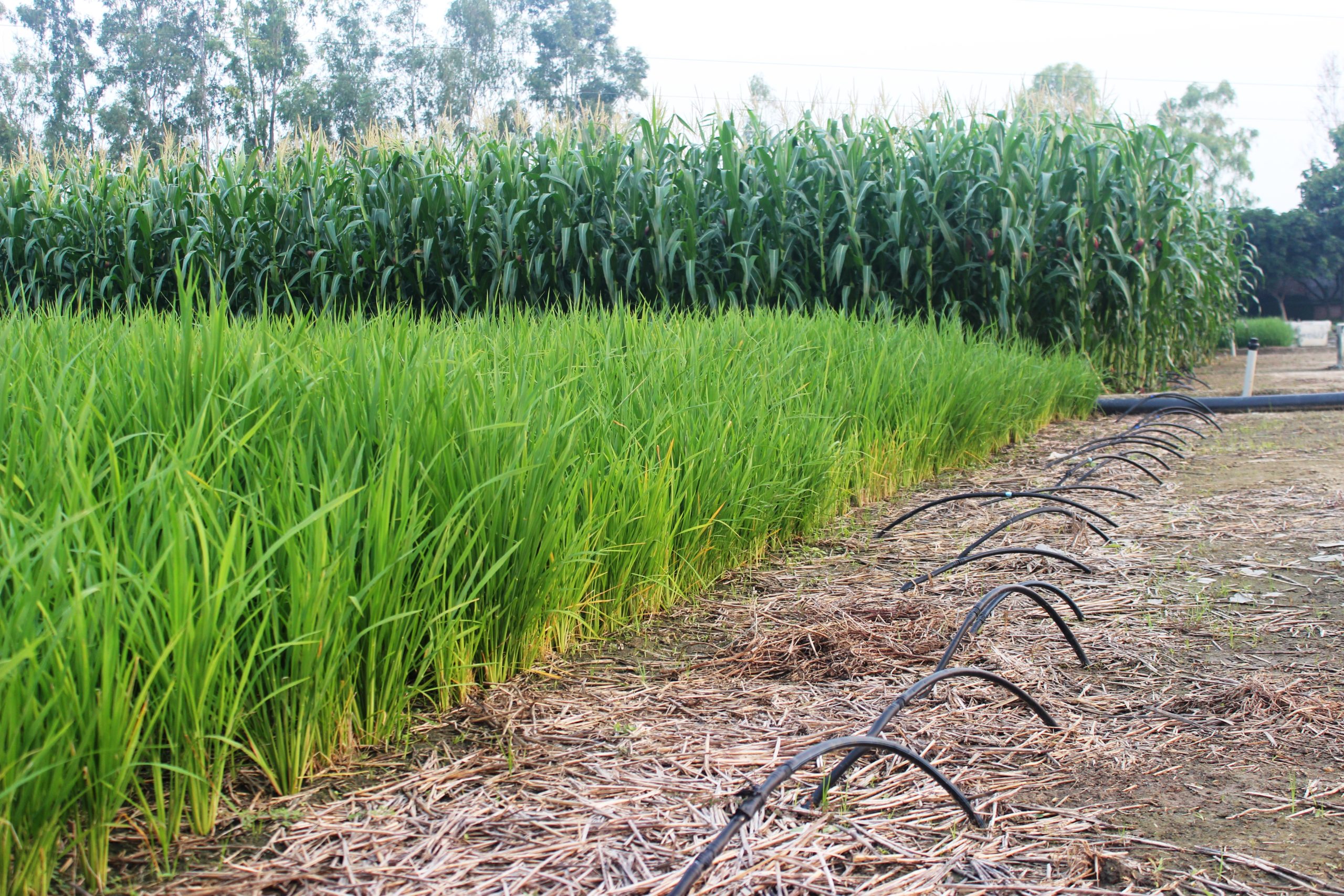
Incentives against subsidies
With increasing water shortages worldwide, making the most out of every drop becomes an urgent priority. But in countries where irrigation systems are highly subsidized, farmers may struggle to see this urgency. India, for instance, subsidizes the cost of energy to pump water for farming, thus encouraging smallholders to extract more than they need.
How do we incentivize farmers in these countries to embrace water-efficient technologies?
According to Jat, using the “scientific card” can work with smallholders who, after having farmed for decades, may not change their minds automatically. “These people may be reluctant to accept incentives for water-efficient mechanisms at first, but they will surely be interested in more scientific approaches,” Jat explained, stressing that “the emphasis must be on the science, not on the technology.”
Designing profitable business models can also incentivize producers to embrace more efficient mechanisms. Farmers who have enjoyed irrigation subsidies for decades may not see any profit in trying out new technologies — but what if they are given the chance to become champions or ambassadors of these agricultural innovations? “That brings in a whole new perspective,” Jat said.
Apart from incentivizing farmers, good business models can also draw the attention of large companies, which would bring investment to boost research and innovation in drip irrigation. “More and more businesses are getting interested in smart agriculture and low emission farming, and their inputs can help conceptualize the future of this field,” he observed.
ML Jat, principal scientist and sustainable intensification strategy leader at the International Maize and Wheat Improvement Centre (CIMMYT), points out some advantages of the bewar system, a climate-resilient alternative to plantation agriculture in India.
In agriculture, good soil management is a pillar of productive systems that can sustainably produce sufficient and healthy food for the world’s growing population.
Soil properties, however, vary widely across geography. To understand the productive capacity of our soils, we need high-quality data. Soil Intelligence System (SIS) is an initiative to develop comprehensive soil information at scale under the Cereal Systems Initiative for South Asia (CSISA) project in India. SIS is led by the International Maize and Wheat Improvement Centre (CIMMYT) in collaboration with ISRIC – World Soil Information, International Food Policy Research Institute (IFPRI), and numerous local partners on the ground.
Funded by the Gates Foundation, the initiative launched in 2019 helps rationalize the costs of generating high-quality soils data while building accessible geo-spatial information systems based on advanced geo-statistics. SIS is currently operational in the States of Andhra Pradesh, Bihar and Odisha where the project partners collaborate with state government and state agricultural universities help produce robust soil health information.
Farmers are the primary beneficiaries of this initiative, as they get reliable soil health management recommendations to increase yields and profits sustainably while state partners, extension and agricultural development institutions and private sector benefit primarily by expanding their understanding for agricultural interventions.
Modern Soil Intelligence System Impact
CIMMYT’s SIS Project lead Balwinder Singh said, “The Soil Intelligence Systems initiative under CSISA is an important step towards the sustainable intensification of agriculture in South Asia. SIS has helped create comprehensive soil information – digital soil maps – for the states of Andhra Pradesh, Bihar and Odisha. The data generated through SIS is helping stakeholders to make precise agronomy decisions at scale that are sustainable.”
Since its launch in December 2019, a wider network and multi-institutional alliances have been built for soil health management and the application of big data in addressing agricultural challenges. In the three states the infrastructure and capacity of partners have been strengthened to leverage soil information for decision-making in agriculture by devising new soil health management recommendations. For example, in the state of Andhra Pradesh, based on SIS data and outreach, State Fertilizer and Micronutrient Policy (SFMP) recommendations were created. Similarly, soil health management zones have been established to strengthen the fertilizer distribution markets enabling farmers with access and informed choices.
“Soil Intelligence System delivers interoperable information services that are readily usable by emerging digital agricultural decision support systems in India”, noted Kempen Senior Soil Scientist at ISRIC.
The three-part infographic highlights the impact of SIS initiative in the select three States and emphasizes the importance of SIS in other parts of the country as well.
